
How to apply digital marketing in 2024? An ultimate guide to reach your targets!

What is Digital Marketing?

What is Digital Marketing?
Digital Marketing Definition
Digital Marketing Strategy
Types of Digital Marketing
SEO Marketing
Email Marketing
Social Media Marketing
Content Marketing
Influencer Marketing
Affiliate Marketing
Marketing Plan
Final Thoughts
What is Digital Marketing
Welcome to the year 2022, where humans spend around 40% of their waking day, online.

No, this is not the synopsis for a new Ridley Scott sci-fi epic, this is present-day Earth. Fear not. There are absolutely zero aliens colonising residential neighbourhoods or doomed interplanetary mining corporations. YouTube may disagree.
Throughout this Ultimate Guide to Digital Marketing, we’ll explore the who, what, why and how, of all things digital marketing. Let’s dive in.
So what is Digital Marketing?
Great question. To answer that we first need to know where it derives from, better known as traditional marketing. Traditional marketing is about trying to connect with a brand audience at the right place and right time. So examples of this would be things like magazine ads, billboards and radio.
Nowadays, the place where we connect is the internet, or online. Digital marketing refers to any form of marketing communication that takes place online, usually via a device such as a computer, mobile device or tablet. We would normally see these various marketing efforts by way of search engines, video, emails, social media and also, text marketing (SMS).
Digital Marketing Definition

What is Digital Marketing?
Digital Marketing Definition
Digital Marketing Strategy
Types of Digital Marketing
SEO Marketing
Email Marketing
Social Media Marketing
Content Marketing
Influencer Marketing
Affiliate Marketing
Marketing Plan
Final Thoughts
Digital Marketing Definition
Digital marketing has become synonymous with raising brand awareness, attracting and growing audiences, and driving traffic or conversions. It’s an essential part of modern business as more and more companies take their products and services online.
Oberlo reported in 2021 that as many as 2.14 billion people bought online.

So, with so many consumers taking their business online; how do you reach them? That’s where digital marketing comes in. Depending on the goal of the business, various digital marketing methods can be utilised, a few of which we’ll explore in the upcoming chapters, but the reason businesses turn to digital marketing over traditional forms is down to some key benefits:
Digital Marketing Strategy

What is Digital Marketing?
Digital Marketing Definition
Digital Marketing Strategy
Types of Digital Marketing
SEO Marketing
Email Marketing
Social Media Marketing
Content Marketing
Influencer Marketing
Affiliate Marketing
Marketing Plan
Final Thoughts
Digital Marketing Strategy
Before you can start dishing out top-notch marketing materials it’s best to have a strategy for how to get there.
Growth hacking is a term currently exploding in the digital space. The keys on our computer would break before we could finish explaining exactly what growth hacking is so we’ll put it like this instead:
Growth hacking is about adopting a curious mindset that craves knowledge. It’s about understanding a company’s metrics for success and focussing all of your attention on making it happen.
G.R.O.W.S. Process by Growth Tribe
The GROWS process is an example of one such process. A 5-step experimental loop for growth hackers.
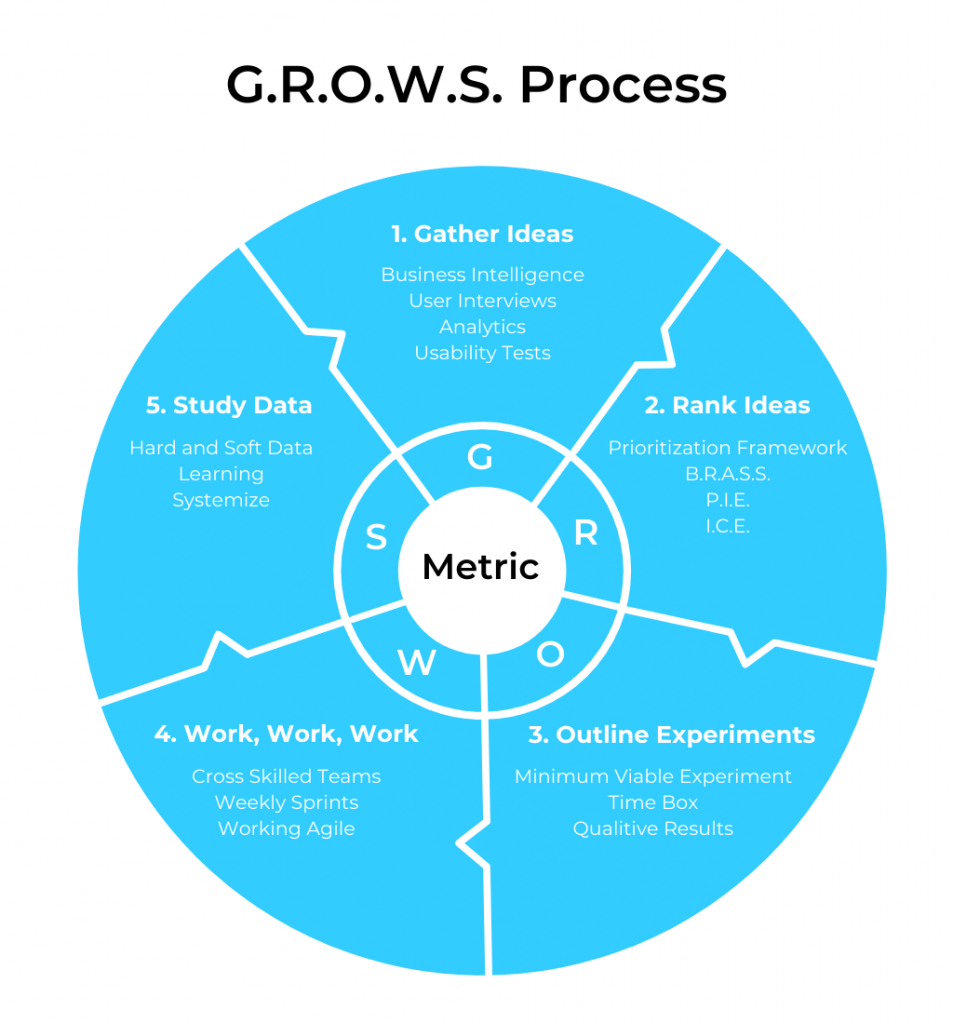
These are the five steps of the GROWS process broken down:
- G - Gather ideas: Just as it sounds, start brainstorming as many ideas as possible.
What we’re looking for here are potential solutions to your customers' biggest pain points. The more you can conjure up at this stage, the easier it will be later on.
Try using the following to guide your research:
- Conduct user tests for customer feedback
- Competitor analysis
- Embrace the diversity of your entire team
- Look at heatmaps
- R - Rank ideas: Sort the wheat from the chaff! In other words, get all of the ideas together and start ranking them from best to worst.
Realistically it would take far too long experimenting with every single idea so narrowing the list down makes life easier. Commonly, growth hacking teams will prioritize ideas using these proven frameworks:
- B.R.A.S.S. framework - which stands for Blink, Relevance, Availability, Scalability, and Score. This decides which customer acquisition channels to test first.
- P.I.E. or I.C.E. framework - standing for Potential, Importance and Ease, and Impact, Confidence and Effort. These methods are great for conversion optimisation, retention or referral.

Now that your concepts are ranked, start with the highest-scoring idea and work your way down.
- O - Outline experiments: Frame how your idea will play out in the experimental phase.
Take this example. You’ve identified a recurring roadblock in the customer journey; users are clicking through the website, viewing the product page but hesitating at the decision stage.
For some reason, they’re not committing.
After some research, the team establish that the CTA needs some work. You decide that by making the CTA button more prominent and by changing the colour, there’s potential for a 30% increase in sales.
Now that we have a framework for what needs to happen, we can start putting together the resources: which team members will be needed and how long the experiment will take.
- W - Work, Work, Work: Stop thinking about Rihanna. But seriously, we forgive you.
There’s not much to add to this stage of the G.R.O.W.S. process, get to work! A couple of useful tips would be:
- Get as much, if not all of the team together. The collaboration will speed things up as well as being able to communicate with teammates quickly.
- Find the right rhythm for your team. Some find that scheduling sprints are effective in iterative creative environments.
- S - Study outcomes: We have a winner! Maybe!
This is where we get to see how the experiment translates into hard data.
Once we have our results we can distribute them to the team, who can implement any necessary changes. For senior management and stakeholders, figures that reflect the financial benefits will have a greater effect.
If the metrics aren’t quite hitting the mark, discuss what can be amended and restart the G.R.O.W.S. loop again.
There really is no losing outcome here, other than the cost of time. If an idea needs revising or changing completely, this will only bring you one step closer to a solution.
AAARRR: The Pirate Funnel
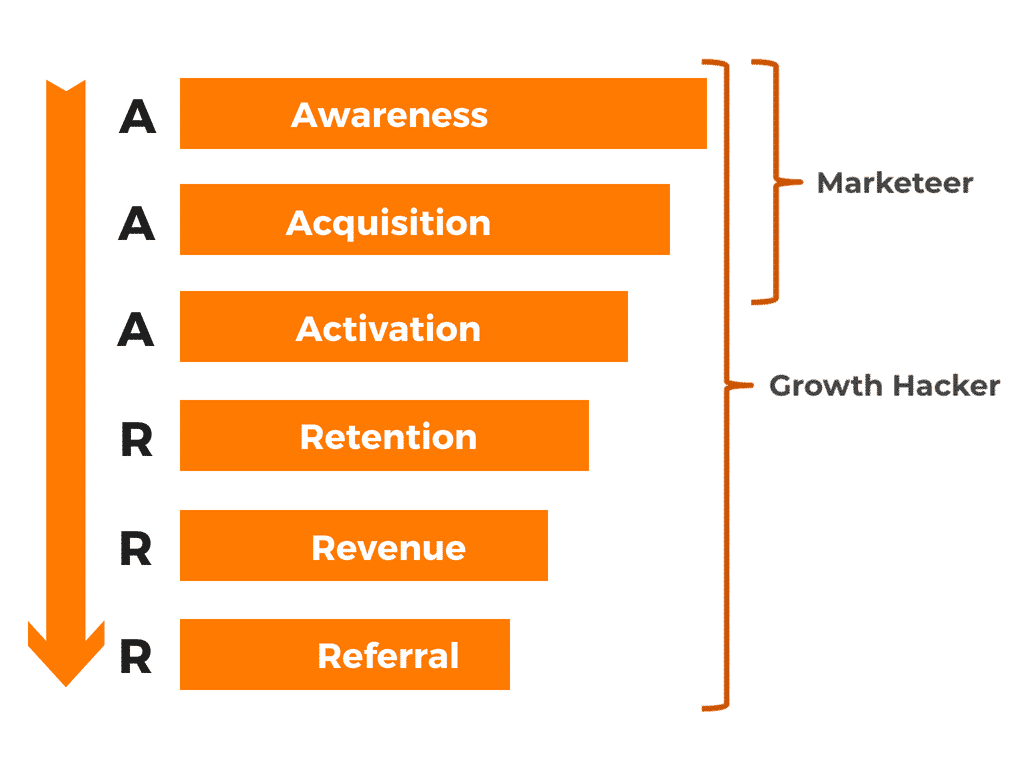
Credit where credit is due - the acronyms these marketing folks come up with are pure gold.
It’s truly something to treasure. Okay, we’ll stop.
The Pirate Funnel, founded by Dave McClure, is used by growth hackers to determine the weakest point in a company and subsequently, how to create exponential growth using the metrics outlined in the Pirate Funnel.
To do this, the Pirate Funnel is broken down into 6 stages:
- Awareness - How many people do you reach?
This is the first point of contact for your customers and introduces the initial question that digital marketers want to know the answer to - how are they finding you?
Interestingly, this stage was not included in Dave McClure’s original funnel but was later added by the Growth Tribe in 2016.
The awareness stage helps growth hackers determine which marketing channels are most effective in reaching your customers and which platforms show the highest engagement.
Typically, this includes:
- Social Media (Facebook, Twitter, Instagram, TikTok etc)
- Google Ads
- SEO (search engine optimization)
- Email Marketing
- Acquisition - How many people visit your website?
The acquisition phase can make or break many new businesses and startups as they attempt to convert visitors into leads.
Marketing strategies like the AAARRR framework help businesses understand how to measure their data properly and where to focus their attention.
So “acquisition” refers to the marketing channels you might use to introduce customers to your product.
Similar to the list above, this will include:
- Social Media
- SEO
- Email Marketing
- SEM (search engine marketing)
- Offline Marketing
- Activation - How many people are taking action?
When your customers arrive at your site, are they taking the desired action and/or next steps?
And if not, then why?
It might be that your site is attracting the wrong customers and to combat this, it’s important to understand your buyer persona. Buyer personas help businesses define their ideal customer to allow more accurate marketing efforts.
Or it could be that the customer can’t see the value in what is being offered and therefore backs out. Whatever the case, the activation phase will shine a light on what needs improving.
- Retention - How many come back and interact with your product?
Customer retention is huge. So big in fact, that it’s reported by increasing your customer retention rates by 5% can increase profits from 25%-95%.
To avoid customer churn, keep an eye out for early warning signs like:
- Infrequent logins
- Length of time it takes to complete tasks
- Shorter visit times
To improve and monitor how many people are returning to your product, the following strategies can help:
- Customer feedback loops
- Customer communication calendar
- Email Automation
- Knowledge and Community Forums
- Revenue - How many start paying? And how much do they pay?
The revenue phase of the Pirate Funnel helps companies assess whether the cost for acquisition and activation is profitable.
An important part of this is calculating the lifetime value of a customer versus their acquisition cost.

This calculation helps define users that are generating:
- Minimum revenue
- Break-even revenue
- Revenue that exceeds the cost of acquisition
- Referral - How many people recommend your company to friends?
The referral phase is about discovering how many of your customers are so super impressed, that they recommend your product/ services to a friend, family member or colleague. Businesses love referrals because when they work, it means the cost of acquisition for the new customer is virtually zero.
The ideal scenario for this viral loop would be:
- Customer discovers your product
- Customer recommends your product
- Gain a new customer from the referral
And to measure the data for how many people are referring, think about strategies like:
For more on growth marketing check out the Growth Tribe course.
Marketing Mix
Quick history lesson. The term Marketing Mix was first developed in 1949 by Neil Borden. Later, in 1960, E. Jerome McCarthy introduced the four P’s of marketing.
These 4P’s are known as Product, Price, Place and Promotion. The Marketing mix concept outlines a framework of thoughtful strategies that drive business growth and successful product promotion.
Skip to today, where digital marketing has become the prominent avenue for brand growth and lead generation, the Marketing Mix concept now contains 7P’s. Adding to the original four, we have People, Process and Physical evidence.
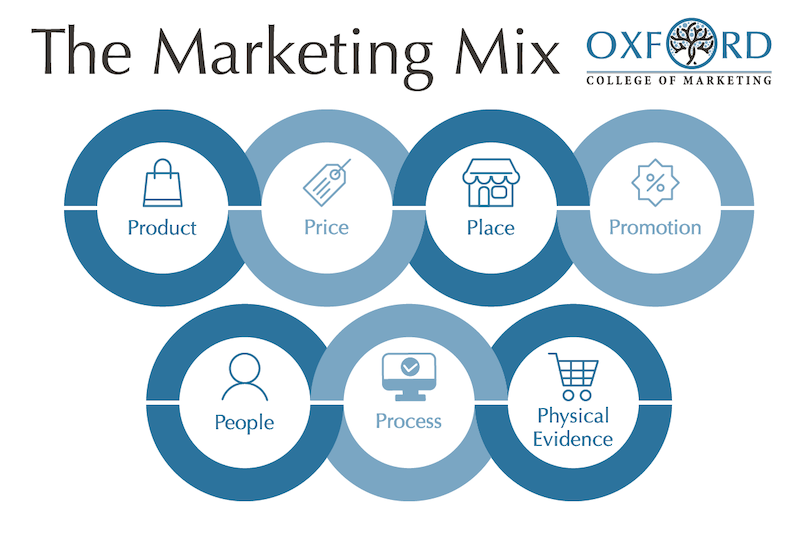
Here’s how these 7 elements are broken down:
- Product
The ultimate goal for any product is to serve the needs of your consumer. Period. All a person wants to know is that your “thing” can help them overcome their thing.
Your product acts as the core of your entire business and because of this, product-led marketing focuses the attention on making a product work for itself.
So with the Product element of the Marketing Mix, we’re considering:
- Price
Shockingly, this one is about the cost of your product…
However, pricing models are not as straight-forward as it seems though, there are a bunch of elements to consider when pricing a product or service, this includes:
- Pricing high to give the impression of a higher-quality product
- Price similar to competitors but emphasize specific features or benefits that attract consumers to your product instead
- Offer the base price at a higher rate to make bundles more attractive
- Deliberately price your product lower to attract value-conscious customers
- Offer Freemium models with tiered upgrades
Suddenly when it comes to pricing, there’s much more to consider than just making your costs back!
- Place
Where will you sell your product? Pre-internet this was a considerably simpler decision.
Sure, deciding where to place your product still required a lot of market research but inevitably you had to decide solely on a physical location.
Nowadays, of course, we have the internet and various ways of getting in front of our customers.
Here are some angles to consider.
- Is it a digital or physical product?
- Where is your target audience likely to be?
- Will you sell directly to consumers with e-commerce or through third-party marketplaces?
- Will you resolve customer issues directly or through third parties?
Answering these types of questions will inform your business as to where the best place for your product is.
- Promotion
This is the part of the marketing mix that your customers see the most. Promotion will include every type of traditional and digital marketing strategy known to humankind. Here are a few examples of how a product could be promoted:
As you can see there are a lot of choices when it comes to promoting your product. Deciding which channels to use, all depends on the product itself and where your audience spends the majority of their time.
For a lot of companies, a combination of both traditional and digital marketing means they can cover more ground for maximum impact.
- People
People refers to anyone that comes into contact with your customers, directly or indirectly at the business level. So this is your marketers, sales team, designers, managers, customer service teams and recruiters or trainers.
The key here is to have everyone singing from the same hymn sheet. Total continuity across the business so that the brand is represented consistently throughout. A few tips for doing just that would be to:
- Train and develop marketers’ skillsets
- Avoid cutting corners and hire professionals to design and develop products
- Use Customer Relationship Management Systems (CRM) to track and build long term relationships with customers
- Define the brand personality like the tone of voice (TOV) and company culture
Remember that the most important thing for your customer is that you can solve their problem. Strategies like the ones mentioned above equip teams to deliver on that goal.
- Process
The process refers to the fundamental steps involved in delivering your product or service to the customer. The idea with this step of the marketing mix is to create seamless and personalised processes for your customers that makes them fans of your company.
You want to avoid any frustrations that may arise from poor communication, unnecessary sales barriers, additional charges and so on.
Ways to optimise this process include:
- Product Packaging
- Optimising the Sales Funnel
- Checkout Process
- Delivery and Shipping
- Customer Service
- Physical Evidence
This part of the marketing mix refers to all of the factors that signal your viability to the customer. Think about the branding, logo design, receipt emails, website, social media, to name a few. These elements define your business and influence the customer journey.
Creating a customer experience that feels incredible and pits your brand as a trustworthy and credible source is paramount to success. To do this, you need to create physical evidence for the customer, here are a few examples of what to focus on:
Types of Digital Marketing

What is Digital Marketing?
Digital Marketing Definition
Digital Marketing Strategy
Types of Digital Marketing
SEO Marketing
Email Marketing
Social Media Marketing
Content Marketing
Influencer Marketing
Affiliate Marketing
Marketing Plan
Final Thoughts
Types of Digital Marketing
If you were to do a quick Google search you’ll no doubt come across some conflicting information about the different types of digital marketing. Some say there are 11, some say 10, some say 8.
For today, we’re going to be settling on the 6 types of digital marketing and how they are used to grow, convert and retain audiences.
Read on for a breakdown of the 6 types of digital marketing!
SEO Marketing

What is Digital Marketing?
Digital Marketing Definition
Digital Marketing Strategy
Types of Digital Marketing
SEO Marketing
Email Marketing
Social Media Marketing
Content Marketing
Influencer Marketing
Affiliate Marketing
Marketing Plan
Final Thoughts
SEO Marketing
SEO or search engine optimization is the process of taking steps to help your website or content rank higher on search engine results. This helps to drive organic traffic (i.e. without paying for ads) and as a result, promote brand awareness, grow followers and increase conversions.
The channels that benefit most from SEO includes websites, blogs and visual content like infographics and video. And while there are multiple search engines available, Google accounts for 92% of the global search engine market so when we talk SEO best practices, we’re talking about what Google likes to see.
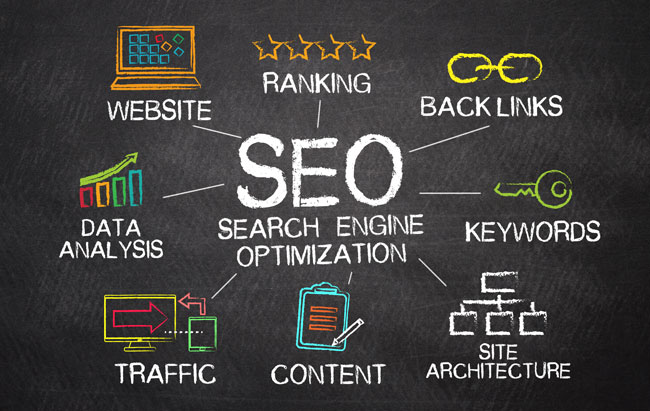
So what’s the point? Well, Google’s primary objective is to present users with the most accurate and helpful results when they submit a search engine query. Google, like everybody else competing in the digital marketing space, are obsessed with building value and great customer experiences.
Let’s say you want to find a local artisan coffee house; you punch your query into Google and wait for the search engine to display the results page (SERP).
For the companies that have utilised SEO effectively, they’ll appear on the first page of results, which is where everybody wants to be. You click through the website link and hopefully find what you're looking for, some tasty small-batch roasted coffee!
Google prioritises the results it thinks will best solve your query by interpreting a couple of core SEO metrics:
On-Page SEO refers to building content that improves your ranking.
Methods for this include:
- Using keywords in content
- Optimising metatags and titles
- Producing high-quality content
- Managing how often you post content
So with on-page SEO, we’re focused on everything that exists on a website so that it can be pushed higher up Google’s rankings.
Off-page SEO refers to the activity happening “off the page”, so not on your actual website. This activity is best known as backlinks.
Backlinking happens when an external publisher (like a blog or YouTube) links back to your site. The authority or credibility of that source determines how high your site will rank for any relevant keywords.
Common methods for earning backlinks are:
- Guest blogging on other sites
- Resource Link Building
- Broken Link Building
- Listicle Link Building
- The Skyscraper Technique
- Testimonial Link Building
HubSpot conducted an excellent case on Canva, detailing how they successfully implemented SEO into their digital marketing strategy.
Email Marketing

What is Digital Marketing?
Digital Marketing Definition
Digital Marketing Strategy
Types of Digital Marketing
SEO Marketing
Email Marketing
Social Media Marketing
Content Marketing
Influencer Marketing
Affiliate Marketing
Marketing Plan
Final Thoughts
Email Marketing
Whilst a slightly older form of digital communication, email marketing still reigns supreme over newer marketing channels with over 4 billion daily users and a massive ROI that generated $42 for every $1 spent in 2021. Email marketing is primarily used to generate leads or sales using promotional content like sales, discounts or nurturing audiences.
The typical types of email marketing campaigns you might see, consist of:
- Customer Welcome Emails - activated after the initial purchase or subscription
- Customer Nurture Emails (tips, series, brand awareness) - usually a series of emails that deliver at set times for example the first, third and seventh day after subscribing
- E-Newsletters - a regular informational email sent at set times for example monthly
- Follow Up Email Series - activated after purchase, consideration or subscription to entice further action from the user.
- Lead Magnet Emails - promotional emails asking users to download a piece of content such as a guide or template
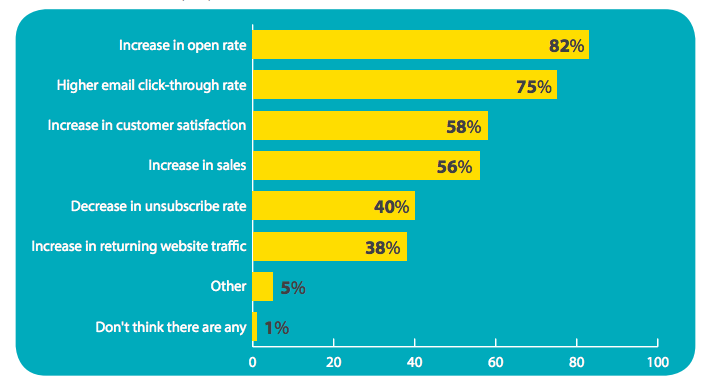
Clearly, there’s a lot to think about here so businesses make light work of email marketing by automating their communication with audiences.
Automation removes the legwork for marketers and makes sure every user gets an optimised customer journey.
Social Media Marketing

What is Digital Marketing?
Digital Marketing Definition
Digital Marketing Strategy
Types of Digital Marketing
SEO Marketing
Email Marketing
Social Media Marketing
Content Marketing
Influencer Marketing
Affiliate Marketing
Marketing Plan
Final Thoughts
Social Media Marketing
Social media marketing is the practice of creating content that promotes your products and services, drives traffic to your website, grows your audience and generates leads or sales.
The benefits of doing so are massive including building brand awareness, becoming an authority in your niche, driving traffic and staying top-of-mind for when people are ready to purchase.
Depending on the industry and what it is you’re selling or promoting, will determine which social media platform is best to market on.
You need to find your social media target audience so as not to generate content that misses its mark.
Most of us are familiar with the different types of social media platforms but to recap, here’s a list of the main competitors:
Whichever platform you decide on, be sure to create content that is valuable, shareworthy and always look to engage with your audience.
To understand the efficacy of your social media marketing campaigns, you’ll need to get a grasp of the basic social media metrics.
This data is drawn from the following:
- Engagement - this includes clicks, comments, likes and replies.
- Reach - how many people have seen your content
- Impressions - the number of times a post from your page or profile has been seen
- Followers - how many people have subscribed/followed your page or profile
- Video Views - how many people have seen your video content
- Mentions - number of times your profile has received a mention from followers
- Tags - number of people that add your profile or hashtag to a post
- Reposts - how many people post your content on their page
- Shares - how many people share your content directly to their network
- Profile Visits - how many people open/visit your page
Social media platforms such as Facebook, Instagram and Twitter all have built-in analytics tools for measuring this data. Or, you can use tools like Google Analytics to see how both your website and social media channels are performing under one roof.
Content Marketing

What is Digital Marketing?
Digital Marketing Definition
Digital Marketing Strategy
Types of Digital Marketing
SEO Marketing
Email Marketing
Social Media Marketing
Content Marketing
Influencer Marketing
Affiliate Marketing
Marketing Plan
Final Thoughts
Content Marketing
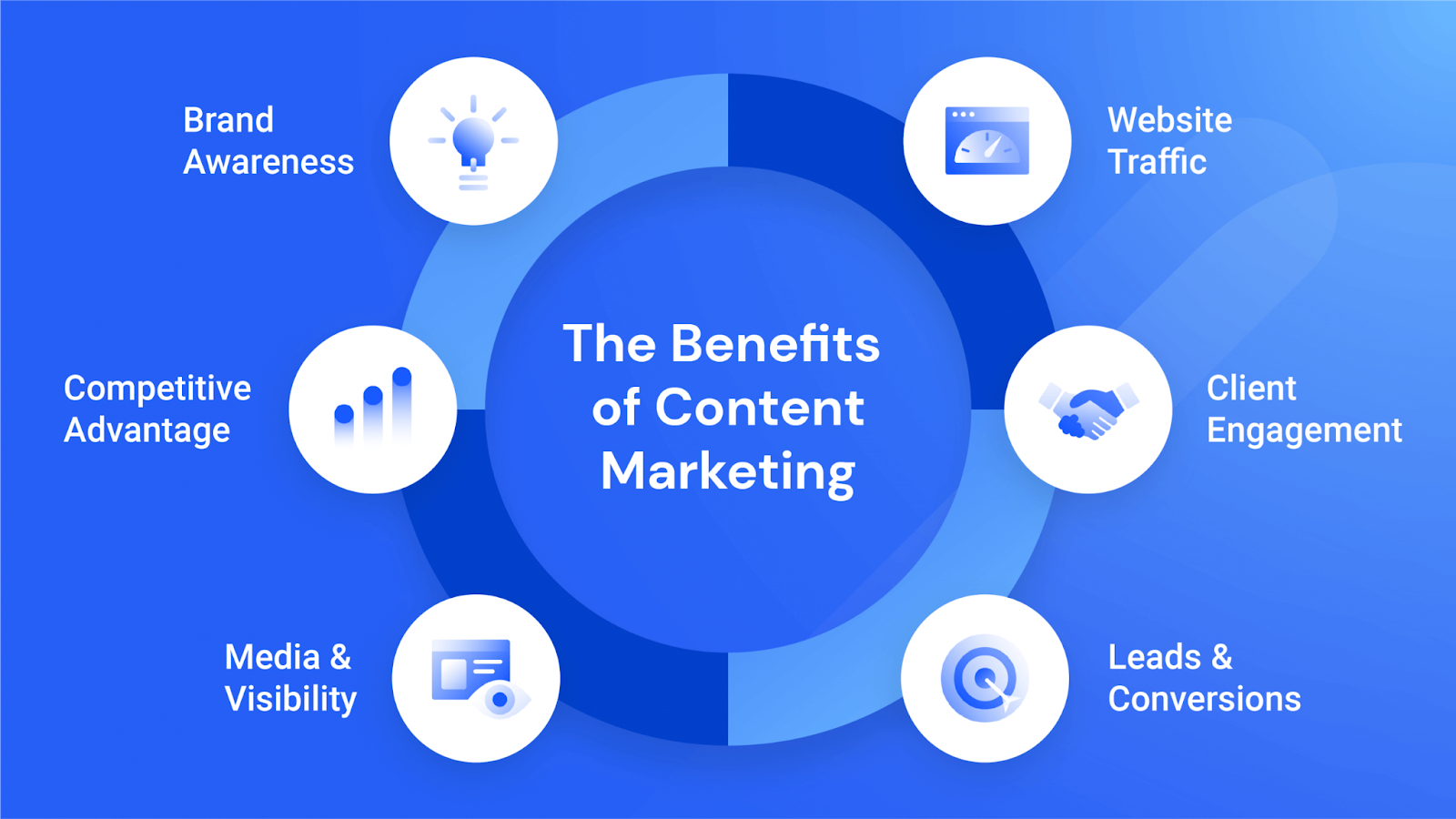
Content marketing is a long term marketing strategy that is used to attract, engage and retain audiences by creating and promoting content.
In today’s digital world, businesses have to continuously assert their authority within their field. This means that content marketing has grown to become a colossal marketing strategy. So big in fact, that a HubSpot study in 2021 showed 82% of marketers are actively investing in content marketing.
Content is a broad term these days, with just about anything that uses graphics or letters qualifying as such. But there are a few concrete examples of content that will directly influence your digital marketing strategy. Here are some typical content marketing channels:
Blog posts are the articles published on a company’s website. Blogs are used to generate organic traffic for your business and generate leads.
This is content created for sharing online via video or through audio experiences such as radio, podcasts or audiobooks.
Infographics are perfect for conveying complex information or large amounts of data through simple and digestible graphics.
- Ebooks and Whitepapers
These are examples of long-form content that educate your audience and progress the customer buyer journey by exchanging content for the reader’s contact information, usually their email address.
The above content strategies are firmly oriented towards long-term relationship building with consumers. Unlike transactional advertising, content marketing aims to nurture and attract loyalty from our consumers, leading to more credibility and trust.
Influencer Marketing

What is Digital Marketing?
Digital Marketing Definition
Digital Marketing Strategy
Types of Digital Marketing
SEO Marketing
Email Marketing
Social Media Marketing
Content Marketing
Influencer Marketing
Affiliate Marketing
Marketing Plan
Final Thoughts
Influencer Marketing
Influencer marketing is the act of taking high-profile personalities or celebrities, with dedicated followings, to promote a product or service. Today, influencer marketing is predominantly associated with Instagram, as the popular social media app is the current leader in marketing spend and performance.
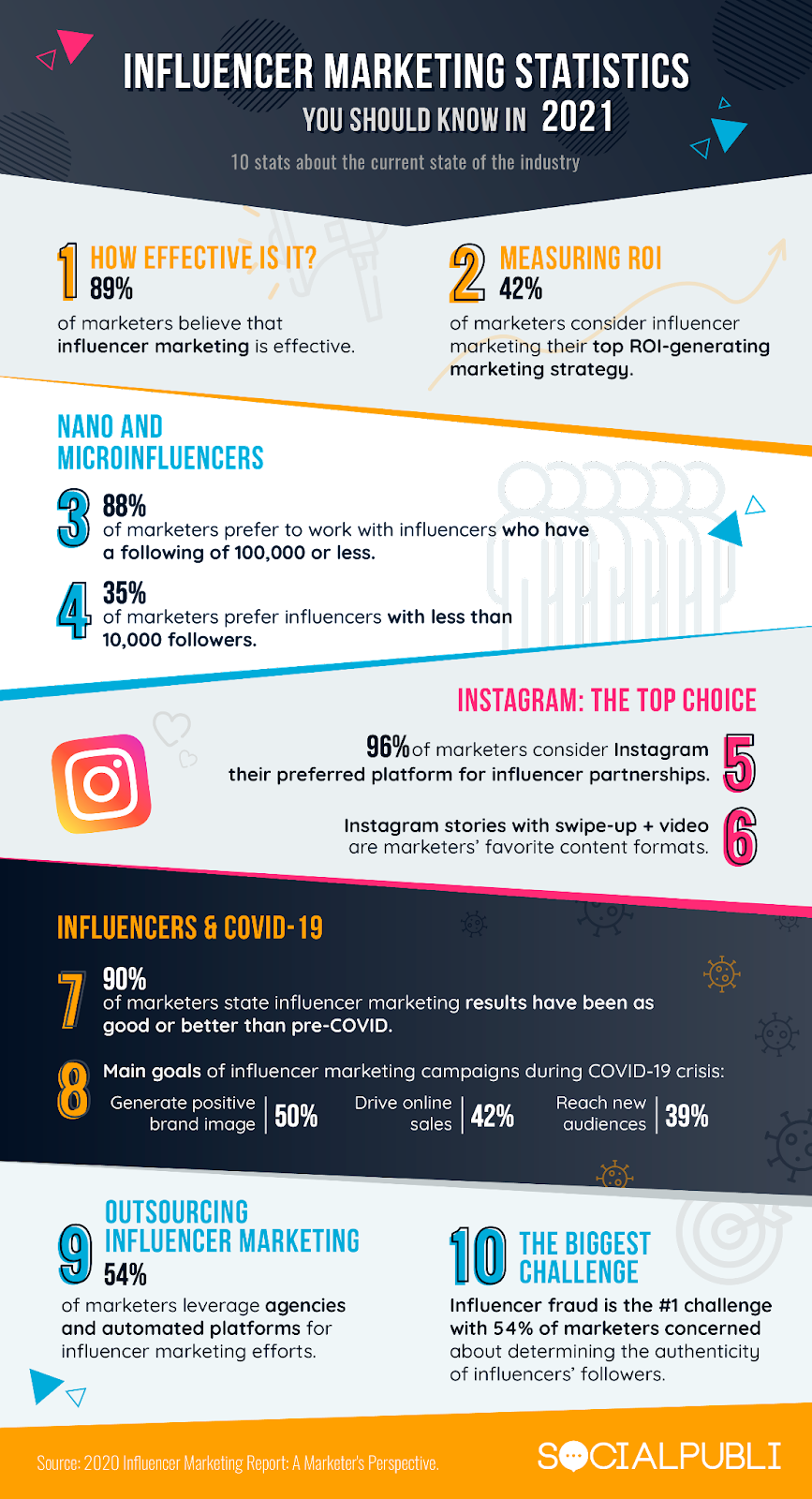
Through collaboration with a dominant figure (the influencer) in your desired market, companies and brands can cut through the noise and attract large audiences. In 2021, 49% of consumers depended on influencer recommendations before making a purchase.
Potential buyers will listen to the recommendations of trusted sources whom they admire and respect. This is where influencer marketing plays a huge role in your digital marketing strategy. Logic might dictate that a business should simply find the most famous influencer with the highest amount of followers and this will guarantee victory! But that’s not necessarily the case.
It all depends on what you’re marketing and to whom you want to market. Here is how marketers define influencers based on their following:
- Nano-influencers: 1,000 - 10,000 followers
- Micro-influencers: 10,000 - 50,000 followers
- Mid-tier influencers: 50,000 - 500,000 followers
- Macro-influencers: 500,000 - 1,000,000 followers
- Mega-influencers: 1,000,000+ followers
When deciding on the best influencer to promote your product or service, keep in mind not to alienate your target audience and collaborate with individuals that share your goals. A high-profile personality with zero interest or affiliation with your company ethics, probably won’t yield the same results as a smaller influencer with a loyal, passionate following, whose principles align with yours.
Affiliate Marketing

What is Digital Marketing?
Digital Marketing Definition
Digital Marketing Strategy
Types of Digital Marketing
SEO Marketing
Email Marketing
Social Media Marketing
Content Marketing
Influencer Marketing
Affiliate Marketing
Marketing Plan
Final Thoughts
Affiliate Marketing
Affiliate marketing is the process of promoting someone else’s product in exchange for a commission each time a sale is made. Popularised by Tim Ferris’s book, The 4-Hour Workweek, the idea of earning passive income from your website and other marketing channels has become a reality for many.
It’s predicted that affiliate marketing spending is due to reach $8.2 billion in 2022.This graphic shows the typical cycle for affiliate marketing:
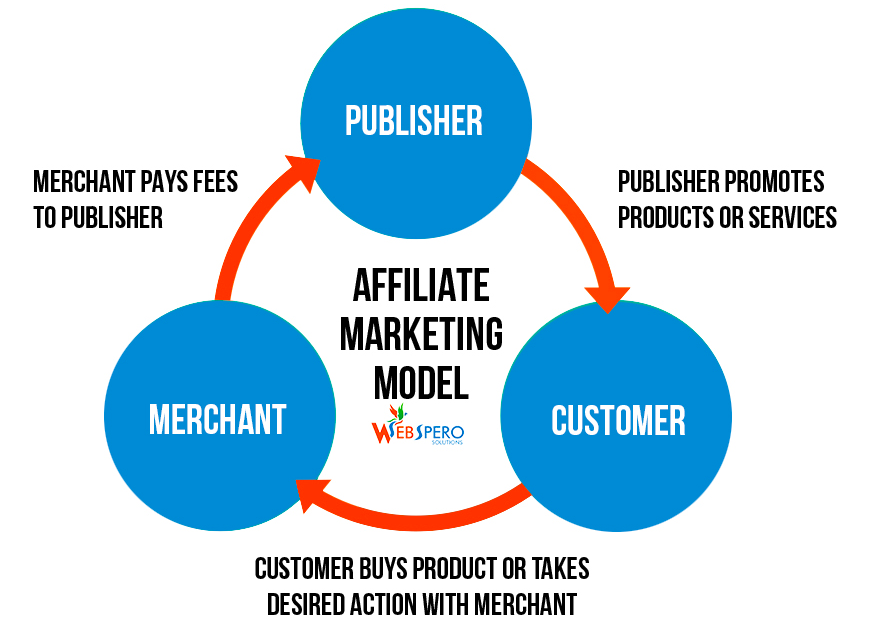
Let’s look at each party’s role in this affiliate marketing model:
- The Publisher or Affiliate
This would be the blogger or content creator writing the blog post or capturing video and other types of media. A unique link (affiliate link) will be posted on the article or in the content that a user can click and complete their purchase.
This process is tracked via cookies and a commission is paid out if the user completes the agreed-upon affiliate action within the allotted timeframe. For example, the user must complete a purchase within 30 days of clicking the affiliate link.
- The Customer
No need to delve into this one folks, this is the actual user completing the action, the customer.
- The Merchant
Merchants are typically the creators or advertisers of the product/service. This can be a solopreneur or a large company or anything in-between. As long as they are offering to pay a commission in exchange for gaining sales, they are a merchant.
In some cases, the merchant may not be the product creator, as is the case with Amazon’s affiliate marketing programme. When it comes to choosing an affiliate marketing program, there are plenty available, each with its own criteria and commission structures. Be sure to weigh up the pros and cons of each program before making a decision.
Marketing Plan

What is Digital Marketing?
Digital Marketing Definition
Digital Marketing Strategy
Types of Digital Marketing
SEO Marketing
Email Marketing
Social Media Marketing
Content Marketing
Influencer Marketing
Affiliate Marketing
Marketing Plan
Final Thoughts
Marketing Plan
Understanding how to optimise a user’s digital experience and meet overarching company objectives is at the heart of digital marketing. In this final chapter, we’ll outline the steps you need to take to form a digital marketing plan that helps to meet these goals.
- Define your goals
What is it you are trying to achieve? This is the first and perhaps most important question of all. Because there are numerous marketing campaigns, all with varying purposes, you have to get clear on your objectives. Not doing so will cost you time, money and fail to deliver the right results. For example, if your goal is to increase brand awareness, you might opt for a social media campaign.
Or if the goal is to increase sales of a specific product or service, you might choose to invest in SEO marketing to get more people on your website. Use SMART goals to add clarity, meaning to make them “specific”, “measurable”, “attainable”, “relevant”, and “time-bound”.
Establishing the goal right at the start will inform everything that follows so take time defining this step.
- Create Buyer Personas
Buyer personas are fictionalised versions of a brand’s ideal customer born out of researching and interviewing members of your target audience. These personas represent the people who are most likely to buy your product or service and are generally created using the following characteristics:
- Location
- Age
- Income Range
- Job Title
- Industry
- Hobbies and Interests
- Ambitions
- Pain Points
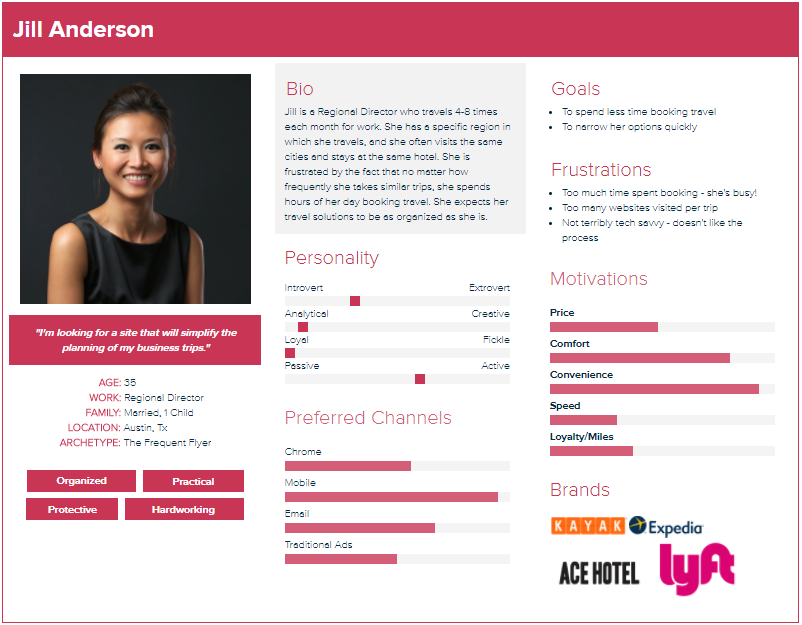
- Choose your digital marketing method
Now that you know have defined your goal and your target audience; the next step is deciding which digital marketing channels will be most effective in achieving that goal.
We’ve already mentioned a few of them in the previous chapters but to recap, here are some of the best digital marketing methods:
- SEO (search engine optimisation)
- PPC (pay-per-click) advertising
- Social Media Marketing
- Influencer Marketing
- Content Marketing
- Email Marketing
Most digital marketing plans will have a mix of free and paid methods to consider, try to strike a balance between paid, owned, earned and shared methods.
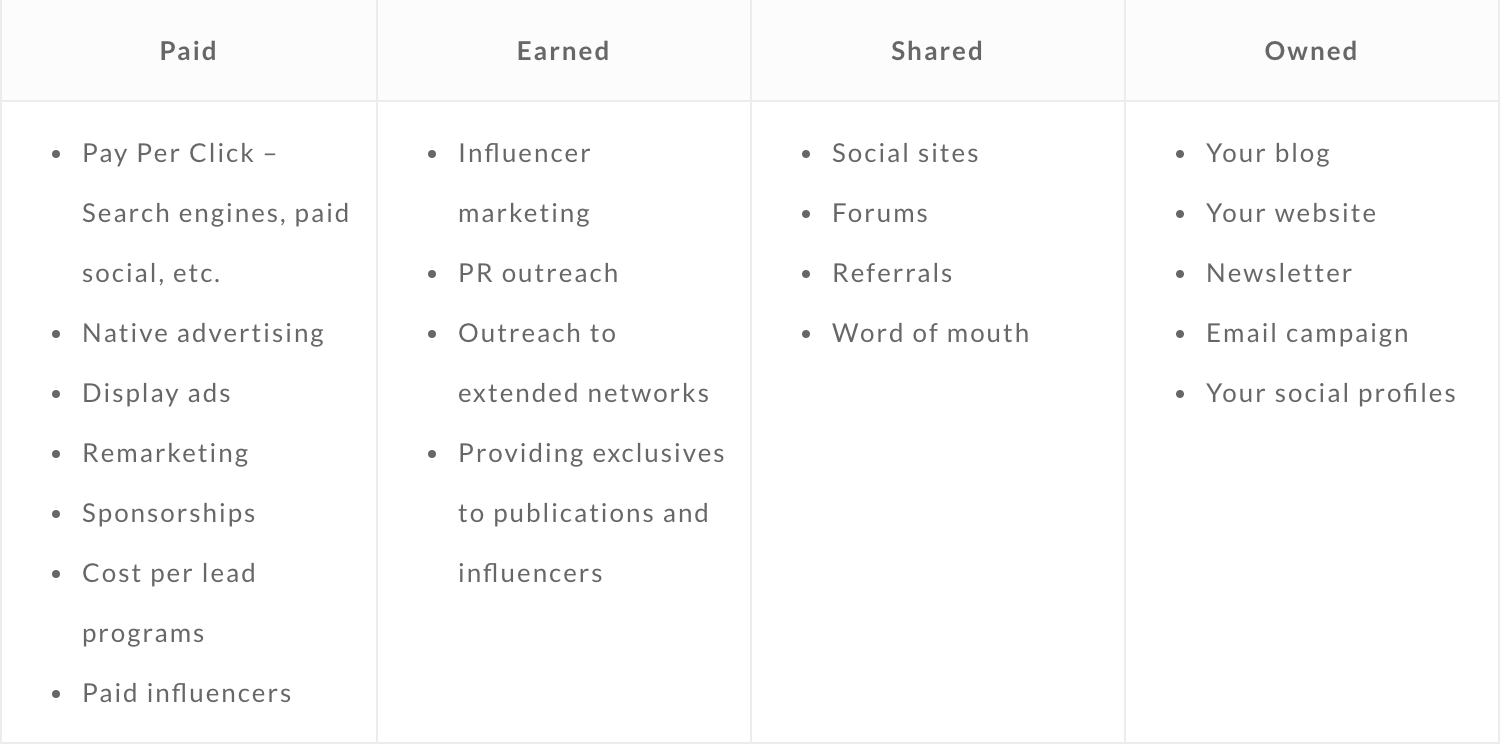
- Decide a budget for each channel
As with business-growth elements you’ll need to have a budget in place before you get to work. This is influenced depending on the focus and goal of the campaign.
For example, if you’re goal is to gain more inbound traffic, you’ll want to generate high-quality content to attract consumers and invest in SEO techniques, like keyword research, to raise the visibility of your site. Although time-consuming, this is a relatively low-expense method.
On the other hand, outbound techniques such as paid advertising will likely incur greater costs.
- Measure your results
To ensure your marketing campaign is on-track and headed in the right direction, you’ll need to measure the results constantly and implement changes ad-hoc.
Depending on the channel and objective you’ve chosen will determine which metrics need to be prioritised but some typical examples are:
- Visits
- Click-through rates
- Bounce rates
- Open rates
- Unsubscribe rates
- Reach
- Impressions
- Conversion rates
- Analyse and reiterate
Analyse the data taken over the course of the campaign to gain clarity on what worked and what could be done better. You might find that one channel drastically outperformed another, causing you to shift focus between platforms. There may have been stages of the campaign that incurred high costs, is there a way to reduce these outgoings?
Did you gain feedback from your customers and how does that influence your goal? These sorts of questions and probing help teams to fine-tune upcoming campaigns for maximum impact.
Final Thoughts

What is Digital Marketing?
Digital Marketing Definition
Digital Marketing Strategy
Types of Digital Marketing
SEO Marketing
Email Marketing
Social Media Marketing
Content Marketing
Influencer Marketing
Affiliate Marketing
Marketing Plan
Final Thoughts
Final Thoughts
Digital marketing is a truly vast but fascinating industry that propels businesses forward in the digital era.
Due to the advances in technology and how they influence consumer interaction, digital marketing is a field constantly on its toes, analysing and adapting to these changes in real-time.
Although there’s a lot to it, digital marketing doesn't have to be overwhelming for businesses. If you follow the basic outlined steps, you’re well on the way to achieving your digital marketing ambitions.
If you’d like to know more about the methods and strategies we’ve touched on in this article or fancy becoming a marketing extraordinaire - check out the Digital Marketing and Growth Marketing courses from Growth Tribe.